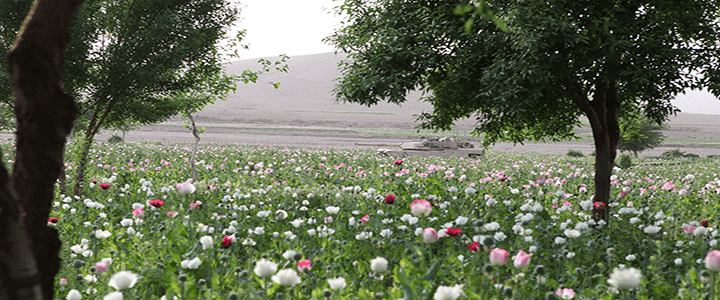On November 19, the coalition forces in Afghanistan took advantage of new, relaxed rules of engagement to strike Taliban drug processing labs in remote parts of northern Helmand province. U.S. F-16 and F-22 fighters, along with B-52 bombers and Afghan Air Force A-29 Super Tucano turboprop close air support aircraft, augmented by the U.S. Marine Corps’ High Mobility Artillery Rocket System, destroyed a total of 10 drug facilities. Carrier-based F/A-18 fighters struck several more drug-related targets on December 7.
The strikes represent a departure not just for the use of U.S. airpower, which the Obama administration had restricted to narrow circumstances, but for U.S. counternarcotics strategy. Such a switch is necessary to cut off the flow of funds enabling the Taliban to keep fighting.
The difficulty in combating opium production
Given the conditions in Afghanistan, it’s hard to blame the average farmer for growing poppies. They don’t require nearly the amount of water that wheat or other food crops do, which is helpful in arid conditions that have at times crossed over into drought. And they fetch a much higher price. But there’s more to it.
Like heroin addicts themselves, Afghan farmers are stuck in a cycle of dependency from which it is nearly impossible to escape. Lending money at interest is forbidden under Sharia, but opium traffickers have found a way around that prohibition. They have for years offered cash-starved farmers payment for their opium crop, at a deep discount, before the flowers are even planted.
Any effort to eradicate the crops themselves would leave the farmers in debt to the traffickers. This in turn feeds further resentment of whoever carried out the eradication — whether coalition forces or Afghan government forces. It doesn’t matter what kind of substitute crop is offered (saffron has been a popular-but-on-again/off-again choice for years) because a new crop offered after the poppy is already planted does nothing to solve the problem of indebtedness to the traffickers.
So the coalition is leaving production alone and going after the refining, where the Taliban is making the money to finance its insurgency.
The Taliban and the Opium Trade
Of all the insidious lies told about the U.S. war in Afghanistan, the worst is “the Taliban halted opium production, and it only restarted because the U.S. invaded.” Such assertions may be technically correct in a narrow sense, but they are completely meaningless.
It is certainly true that the Taliban outlawed the growing of poppy in 2000, and that satellite imagery combined with United Nations ground surveys revealed that only 8,000 hectares of poppy were under cultivation, down from 82,000 the year before. And it is true that much of that poppy production was in northern areas beyond the Taliban’s control. But the Taliban’s actions did nothing to slow the drug trade. In fact, it was done simply to boost the Taliban’s profits.
Pakistani journalist Ahmed Rashid wrote the must-read book for anyone who wants to understand how the Taliban come to power and how they held power. Taliban was originally published in 2000, and updated with post-invasion details in a second edition in 2010. Rashid states bluntly, “The Taliban had banned opium production for a year in 2000 because overproduction had led to a collapse of the price of heroin.” It was, as officials told a U.S. Institutes of Peace researcher, “the ultimate insider-trading act.”
By the time of the poppy ban, according to U.N. assessments, the Taliban’s stockpile of opium could have kept the world supplied for four years. Halting production nevertheless led to fears of a shortage, causing the price to shoot from $28 a kilo to as much as $400 a kilo almost overnight. By the time the Taliban-supported al Qaeda terrorists attacked the U.S. on September 11, the price was up to $746 per kilo.
Afghanistan still produces as much as 85 percent of the world supply of opium and heroin. And the money from that trade has reinforced the Taliban’s position as one of the world’s leading narco-terrorist organizations, keeping their insurgency alive. Theirs is no longer an ideological or religious fight, it is a fight to maintain their lucrative drug trade.
That, to me at least, is the real opioid crisis.




